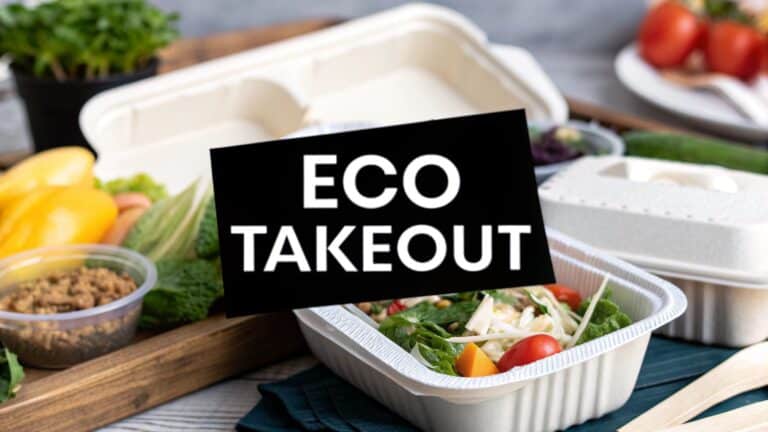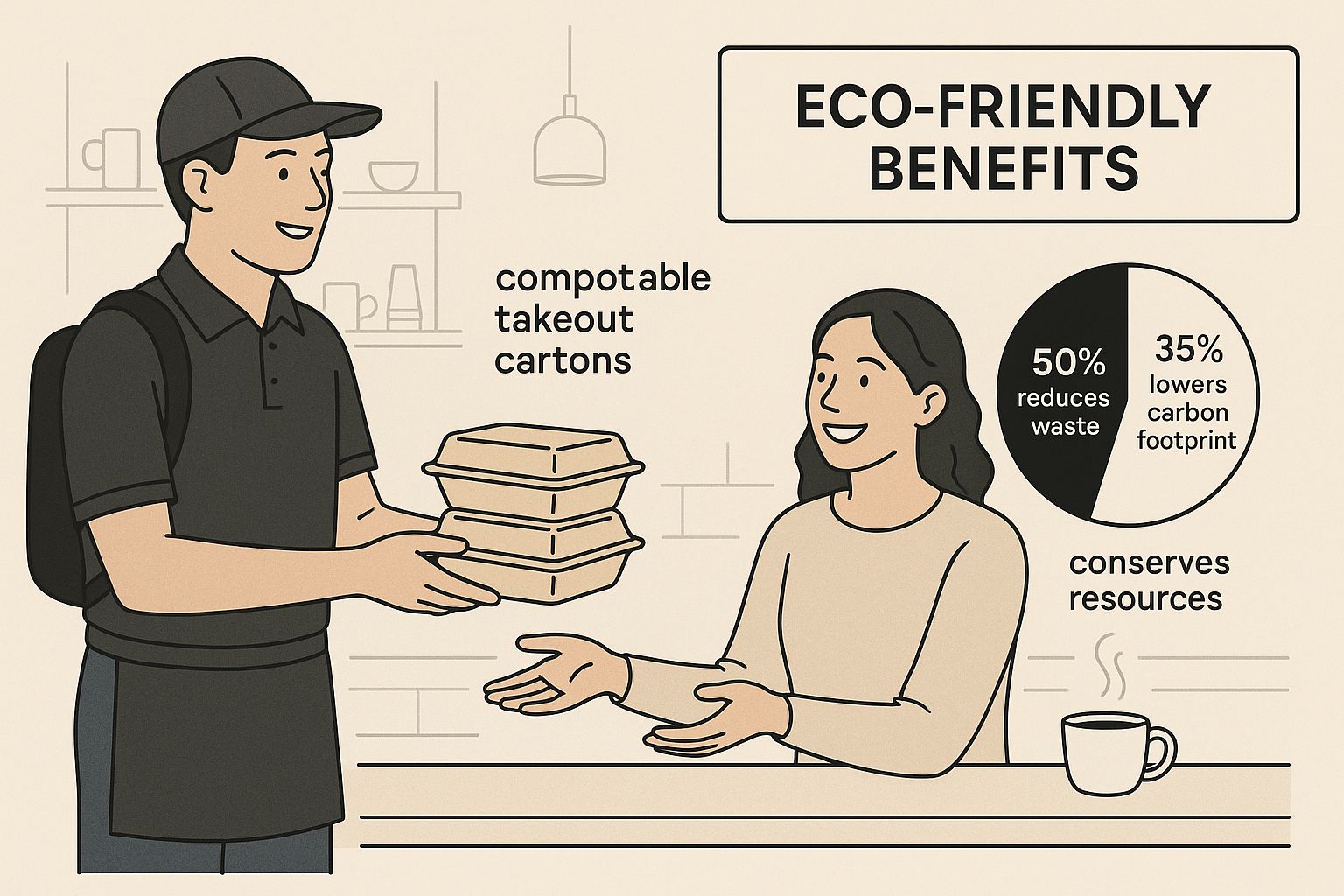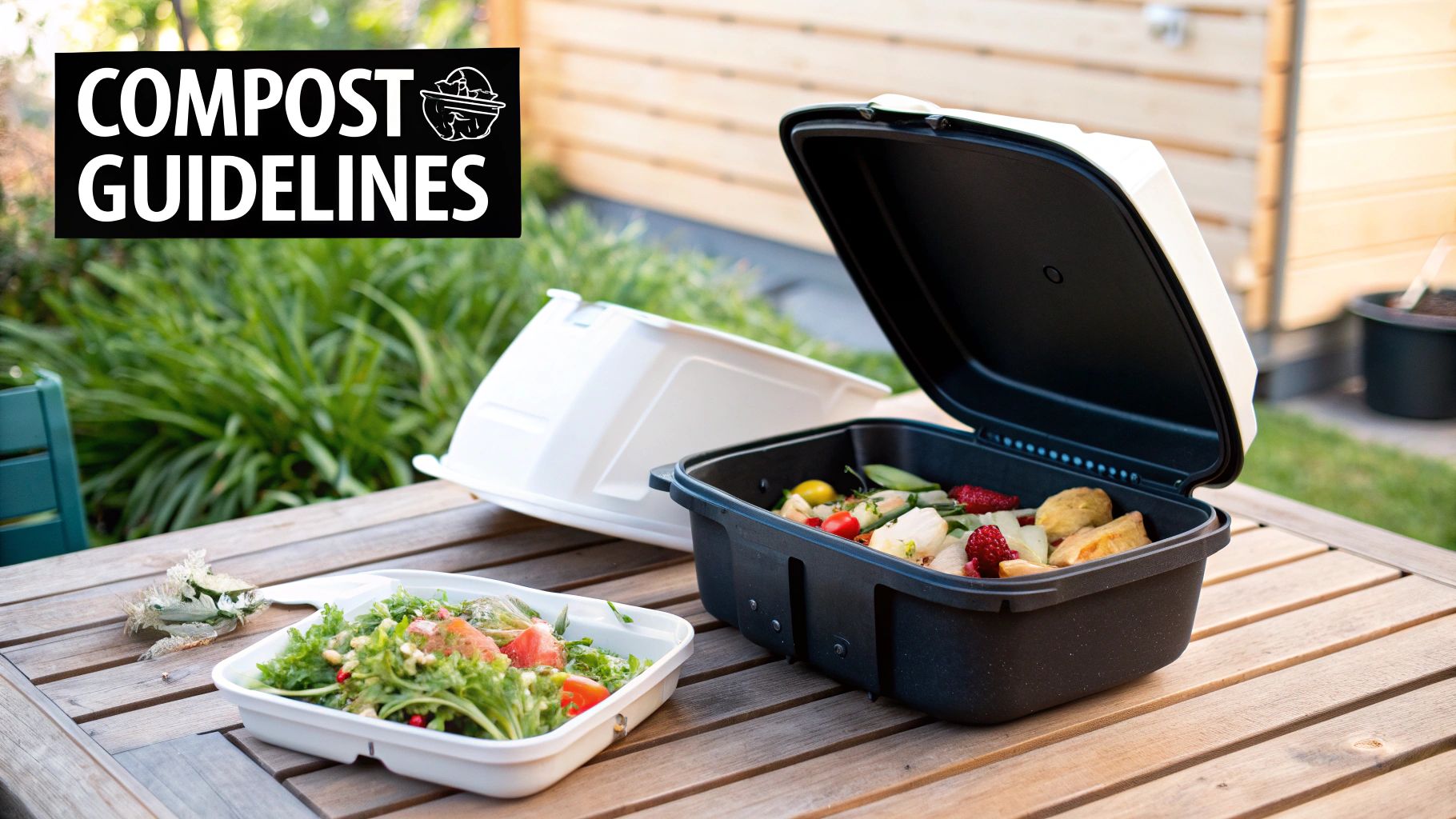The Real Story Behind Compostable Takeout Containers
Compostable takeout containers are gaining popularity. But what does “compostable” really mean? It’s more complex than it appears, and it’s crucial to understand the difference between compostable, biodegradable, and recyclable. These terms are often confused, but they describe different processes with distinct environmental effects. This confusion can lead businesses to make choices that aren’t as environmentally sound as they might think.
Understanding Compostability Certifications
Truly compostable products break down into organic material under specific conditions within a given timeframe. These conditions are usually found in commercial composting facilities, not home compost bins. This is where certifications like BPI (Biodegradable Products Institute), ASTM D6400, and EN 13432 become important. These standards guarantee a product will compost fully, without leaving harmful residue.
For instance, BPI certification requires products to decompose within a specific timeframe and meet strict plant growth standards. This ensures certified products contribute to healthy soil.
Debunking Compostability Myths
A common misconception is that all compostable materials break down rapidly. The reality is that decomposition time depends on several factors, including the material and the composting environment. Another myth is that compostable products can go in with regular recycling. This is a major issue, as it can contaminate the recycling process and make entire batches unusable.
Clear labeling and consumer education are vital to address this. If you want to find out more about the history behind this, we wrote a great study about how sustainable takeout packaging evolved from the paper bag.
The Growing Market for Compostable Solutions
The movement toward environmentally responsible practices has spurred growth in the compostable takeout container market. By 2024, this market reached a value of about USD49.76 billion, a significant increase. This growth stems from various factors, including growing consumer awareness of environmental issues, stricter regulations on plastic waste, and the foodservice industry’s embrace of sustainable packaging.
As consumers prioritize environmental responsibility, businesses are adapting by adopting solutions like compostable takeout containers. Leading companies are investing in research and development to improve the durability and affordability of these containers, furthering market growth.
This trend highlights the increasing importance of sustainable practices in the food sector. Understanding what “compostable” truly means empowers both businesses and consumers to make educated decisions that genuinely benefit the planet.
Breaking Down The Materials: What’s Actually In Your Container
Beyond the “eco-friendly” label, what truly makes a compostable takeout container? The world of sustainable materials is diverse, changing how we package food. This exploration delves into materials from bagasse (sugarcane fiber), a way to repurpose agricultural waste, to innovative mycelium (mushroom) packaging.
This infographic highlights the eco-friendly exchange between a delivery worker and a customer. It emphasizes the benefits of compostable containers and reinforces the growing consumer demand for sustainable practices in the food service industry.
Exploring Material Performance
Different materials have different strengths. Some, like PLA (polylactic acid), a bioplastic derived from cornstarch, are excellent for cold foods. However, they might not hold up to hot liquids.
Others, like bagasse, are sturdy enough for hot soups and greasy dishes. This is where understanding material properties becomes crucial for matching the container to the food. Imagine serving piping hot curry in a PLA container – it probably wouldn’t end well!
Here’s a table to help illustrate the differences among these compostable container materials:
Comparison of Compostable Container Materials
| Material | Heat Resistance | Moisture Resistance | Composting Time | Cost Level | Best For |
|---|---|---|---|---|---|
| Bagasse | High | Moderate | 2-3 Months | Low | Hot and greasy foods |
| PLA | Low | High | 3-6 Months | Moderate | Cold foods, salads |
| Mycelium | Moderate | Moderate | 1-2 Months | High | Fragile items, cushioning |
| Bamboo | Moderate | Moderate | 4-6 Months | Moderate | Dry foods, snacks |
As you can see, each material brings unique characteristics to the table. Choosing the appropriate material hinges on a thorough understanding of these differences.
Bagasse: A Sturdy And Versatile Option
Bagasse, a byproduct of sugarcane processing, offers a strong and compostable solution. It’s heat-resistant and can handle various food types, making it a practical choice for restaurants.
Additionally, using bagasse diverts agricultural waste from landfills. This offers a double environmental benefit and makes it a popular choice for businesses seeking sustainable packaging.
Mycelium: The Future Of Packaging?
Mycelium, the root structure of mushrooms, is a fascinating new material for compostable takeout containers. It’s grown using agricultural waste, requiring minimal resources.
However, mycelium packaging is still relatively new. It can be more expensive than other options. Some companies are exploring mycelium for protective packaging due to its cushioning properties.
Choosing The Right Container For Your Needs
Selecting the right compostable container depends on several factors:
- Food type: Will it be hot, cold, wet, or oily?
- Delivery method: Will the container need to withstand transport?
- Cost considerations: What’s your budget?
- Composting facilities: Are there accessible facilities that accept your chosen material?
This careful evaluation ensures your switch to compostable takeout containers supports both your business needs and your sustainability goals.
The Environmental Impact You’re Actually Making
Switching to compostable takeout containers offers more than just a feel-good moment. It represents a tangible, positive step towards environmental responsibility. We can measure this impact with data and real-world examples, showcasing the concrete benefits. These containers pave the way for reducing our reliance on materials that linger in landfills for decades.
Quantifying the Benefits of Compostable Containers
A life-cycle analysis helps us measure the positive effects of these containers. This analysis considers the entire journey, from sourcing raw materials and manufacturing to decomposition. This comprehensive view reveals how compostable containers shrink carbon footprints and decrease our dependence on landfills.
For example, using plant-based materials like bagasse reduces our need for petroleum-based plastics, a major contributor to greenhouse gas emissions. Furthermore, diverting food waste and compostable containers from landfills significantly reduces methane production, a potent greenhouse gas.
In 2025, the global compostable takeout container market reached approximately $88.61 billion. This growth reflects a rising demand for eco-friendly products and supportive government policies. This market expansion highlights the growing understanding of the crucial role compostable packaging plays in a sustainable future.
From Waste to Resource: The Power of Composting
Proper composting transforms waste into a valuable asset: nutrient-rich soil. This process lessens the burden on landfills while enriching the earth.
However, achieving this requires efficient composting systems. Access to commercial composting facilities is key to maximizing the environmental advantages of compostable containers. It offers additional insights into how these sustainable choices contribute to a healthier planet.
Building Customer Loyalty Through Sustainability
Customers are increasingly choosing businesses with genuine sustainability initiatives. Restaurants and delivery services that use compostable containers demonstrate a real commitment to environmental stewardship. This commitment can boost brand image and cultivate customer loyalty.
For instance, showcasing your use of compostable packaging on menus and websites can attract environmentally conscious consumers. This open communication builds trust and underscores the value of your sustainable choices. As a result, using compostable takeout containers becomes a powerful tool for setting your business apart in a competitive marketplace.
Market Shifts That Are Changing the Game
The world of compostable packaging is evolving quickly. Are you staying informed? This section dives into the market forces reshaping sustainable food packaging, from evolving consumer preferences to new regulations. We’ll also explore how businesses are innovating traditional packaging through strategic partnerships and cutting-edge technologies.
Consumer Demand and Regulatory Pressures
Consumers are increasingly aware of environmental issues. This heightened awareness translates into a preference for businesses that embrace sustainability. Many actively seek out restaurants and food delivery services that use compostable takeout containers. This shift in consumer behavior is a major market driver.
Governments are also playing a role by implementing stricter regulations on single-use plastics. This regulatory pressure further encourages the adoption of compostable alternatives. These regulations present both challenges and opportunities, prompting businesses to adopt more sustainable practices. For example, some cities have banned polystyrene containers, compelling restaurants to seek eco-friendly alternatives.
Innovation and Disruption in Packaging
Companies are embracing innovation to stay ahead of the curve. Strategic partnerships are developing between packaging manufacturers, compostable material suppliers, and technology developers. These collaborations result in improved products and more efficient composting methods.
Advancements in materials science also create new possibilities. Some companies are exploring seaweed-based films and bioplastics derived from agricultural waste. These innovative materials offer enhanced performance and a reduced environmental footprint. The compostable packaging market, including takeout containers, is poised for significant growth.
Let’s take a look at the projected market growth:
Global Compostable Takeout Container Market Growth
| Year | Market Size (Billion USD) | CAGR (%) | Key Growth Drivers |
|---|---|---|---|
| 2024 | 92.56 | – | Rising environmental awareness, reduction of plastic waste |
| 2025 | 100.44 | 8.5 | Increased use of bio-based materials |
| 2029 | 137.26 | 8.1 | Continued consumer demand, stricter regulations |
This table highlights the projected growth of the compostable takeout container market, emphasizing key drivers such as increasing environmental awareness and government regulations. The market is expected to reach $137.26 billion by 2029, showcasing significant potential.
Regional Adoption and Competitive Advantages
The adoption of compostable takeout containers varies geographically. Regions with robust composting infrastructure and supportive regulations often experience faster adoption rates. Other areas may face challenges, such as limited access to commercial composting facilities.
Even in areas with less developed infrastructure, businesses are adapting. Some restaurants collaborate with local farms or community composting initiatives. This proactive strategy allows them to offer sustainable options while supporting local solutions.
Restaurants and delivery services are leveraging sustainable packaging to differentiate themselves. They promote their eco-friendly practices to attract environmentally conscious customers. This can build customer loyalty and enhance brand recognition. In a competitive market, sustainability can be a key differentiator.
The Economic Reality of Compostable Containers
The initial cost of compostable takeout containers can sometimes be higher than traditional alternatives. However, the long-term benefits often outweigh the upfront investment. Reduced waste disposal costs, a stronger brand image, and potential tax incentives can contribute to a positive return on investment. As demand increases and production scales up, the cost difference is also expected to shrink. Many businesses recognize that investing in compostable packaging aligns with their values and resonates with their customer base. This shift towards sustainability represents a fundamental change in business operations and consumer choices.
Overcoming the Real-World Hurdles to Implementation
Switching to compostable takeout containers presents genuine challenges for businesses. Let’s address these obstacles and explore practical solutions. This means honestly examining the difficulties faced by restaurant owners and food service managers, from the initial investment to how well the containers perform with different kinds of food. As more restaurants and foodservice companies explore sustainable packaging, understanding evolving consumer expectations is crucial.
Addressing Cost Concerns and Performance Limitations
One of the biggest hurdles is the higher upfront cost of compostable containers compared to traditional options. This can be a significant barrier, especially for smaller businesses with limited budgets. However, a phased implementation can help. Start by transitioning a portion of your takeout packaging to compostable alternatives, gradually increasing the percentage as your budget allows.
Another issue is that some compostable containers aren’t ideal for all foods. Certain materials may not be suitable for hot or oily dishes. Carefully evaluating various compostable materials and selecting those best suited to your menu is key. Testing different containers with your specific dishes is essential.
Tackling the Infrastructure Gap
A significant obstacle in many areas is the limited availability of commercial composting facilities. If your local waste management system doesn’t offer commercial composting, your compostable containers could end up in a landfill, negating their environmental benefits.
However, innovative solutions exist. Some restaurants partner with local farms or community gardens for composting. Others establish their own small-scale composting systems. Exploring these alternative approaches can help ensure your containers are composted effectively.
Managing the Transition and Empowering Your Team
Transitioning to compostable containers necessitates operational adjustments. Staff training is vital. Your team needs to know how to use the new containers, which bins are appropriate, and how to address customer inquiries. Providing clear, concise training materials is essential for a seamless shift.
Customer communication is equally important. Clearly communicate your switch to compostable containers to your patrons. Emphasize the environmental benefits and provide clear instructions on proper disposal. This transparency can transform your sustainability initiatives into a powerful marketing tool.
Turning Sustainability into a Brand Strength
While implementing compostable takeout containers presents challenges, these obstacles are manageable with careful planning and execution. By addressing cost concerns strategically, selecting the appropriate materials, and finding viable composting solutions, restaurants can make a real difference. Thorough staff training and transparent customer communication are also critical for success.
Ultimately, adopting compostable takeout containers isn’t just about environmental responsibility; it’s about building a stronger, more sustainable business model. It demonstrates a commitment to the community and the planet, which can resonate strongly with customers and contribute to increased customer loyalty and a positive brand image.
Your Roadmap to Successful Implementation
Transforming your takeout packaging to a compostable system requires careful planning. This roadmap guides you through each step, from assessing your needs to communicating your sustainability initiatives to your customers.
Conducting a Packaging Audit
First, understand your current packaging usage. A packaging audit analyzes the types and quantities of containers you use. This helps identify areas where compostable alternatives can easily replace current solutions. Consider factors like the food you serve, portion sizes, and delivery methods. For instance, a salad-focused restaurant will need different compostable containers than a soup restaurant.
Evaluating and Selecting Suppliers
Choosing the right supplier is essential. Look for suppliers with reputable certifications like BPI, ASTM D6400, or EN 13432. These certifications guarantee compostability. Also, assess supplier reliability, ensuring they can meet your volume and delivery needs. Request samples and test them with your food.
Managing the Transition
Switching to compostable containers doesn’t have to be disruptive. Consider a phased approach. Start with a specific menu item or a portion of your takeout orders. This lets your staff adapt and gather customer feedback before a full-scale launch. Check out this guide on better marketing your brand with custom to-go containers.
Calculating the Financial Impact
While the initial cost of compostable containers might be higher, analyze the overall financial picture. Consider potential long-term savings like reduced waste disposal fees. Factor in potential increases in customer loyalty. Customers appreciate businesses committed to sustainability. This can lead to higher sales and a better brand reputation. Some areas even offer incentives for using compostable packaging.
Staff Training and Customer Education
Effective communication is vital. Train your staff on the proper use and disposal of compostable containers. Prepare them to answer customer questions accurately. Create clear educational materials for customers explaining the switch and how they can participate in the composting process. This turns potential confusion into a positive customer experience.
Marketing Your Sustainability Commitment
Highlight your switch to compostable packaging in your marketing. Promote your eco-friendly choices on your website, menus, and social media. This attracts environmentally conscious customers and builds loyalty. Consider using labels or stickers on the containers themselves to reinforce your commitment.
Case Studies: Success Stories Across the Industry
Businesses of all sizes have successfully adopted compostable takeout containers. Studying their methods can offer valuable insights. Some partner with local composting facilities; others have in-house solutions. Learning from these real-world examples can guide your implementation.
This roadmap provides a foundation for integrating compostable takeout containers into your business. By addressing practical aspects and communicating your sustainability efforts, you create a system that benefits your business and the environment.
Ready to make the switch? Explore compostable options at MrTakeOutBags.com.






Comments are closed.